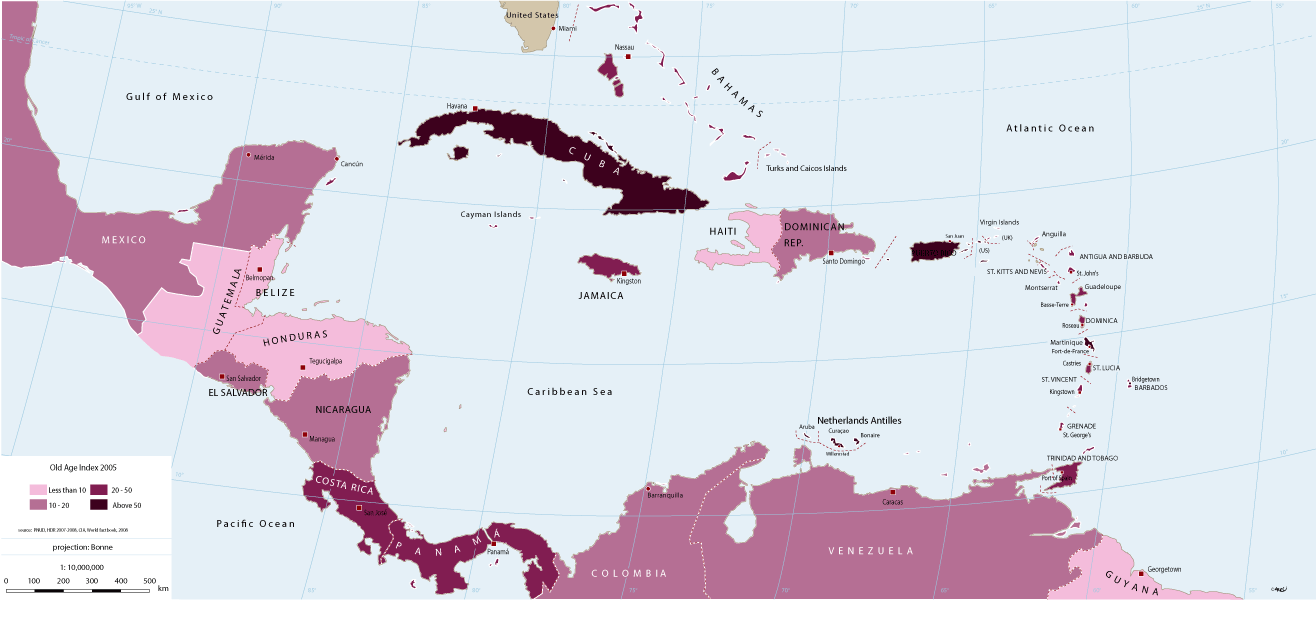
- Ageing (2005-2020)
- Demographic patchwork
- Demographic transition (1999-2005)
- Demographic transition (2005-2008)
- Demographic transition (2012)
- Développement humain (2017-2018) FR
- Génocide, immigration, traite FR
- Human Development (1994-1995)
- Human Development (1997-2000)
- Human Development (2005)
- Human development (2012)
- Naître, vivre et mourir aux Caraïbes FR
- Niveau de développement et situation démographique 2022-2023 FR
- Over-sized capitals (2008-2012)
- Population densities (2008)
- Population densities (2010-2011)
- Population et densités (1997) FR
- Population et densités (2000-2005) FR
It might appear untimely to be interested in the ageing of the Caribbean's population, given that some of its countries have barely attained their demographic transition, and that others are only a the early expanding stage of the classic sequence. However, the ageing of a population, even if today appearing seemingly insignificant, may become an over-riding preoccupation in the short term for both national and local authorities. The difficulties currently facing so-called developed countries in managing both the immediate and longer term consequences of their ageing demographic structures is but a glimpse of what awaits the countries of the Caribbean in the next 20 years, and for two principal reasons:
- The population totals in question for certain states (Mexico, Colombia) find no parallels with these already evident in ‘Old Europe.' The inflated numbers are the direct inheritance of the demographic transition and the consequent raises in population during phase I (high birth rate / rapidly declining mortality rate).
- The support systems for the aged are little developed, and the management of old age and the costs of dependency are left to the families themselves.
The initial consequence for the longer term of the demographic transition cycle is a progressive ageing of a country's population, commonly referred to as the post-transitional phase. The generations born during this early phase of the transition will themselves produce-growing contingent of newly born who one day will grow old. The UNESCO forecast at the end of 2000 already appeared alarmist: “(...) ageing will obtain spectacular proportions in the developing world (...), countries like Brazil, Mexico, Nigeria will see their aged population increase fifteen-fold (...).”
1. Current situation
Pre ageing of demographic structures in the Caribbean is still only in its initial stage, but already it is possible to identify different trends in relation to the proportion represented by the over 64 age group by comparison to the youngest cohort (less than 14 years). The old age index based on this ratio between the youngest and the oldest is around 28 for the Caribbean region as a whole, still a long way from any onset of demographic ageing. But this conclusion relates only to a regional average, in reality in many states ageing of the population is already well underway. Three stages are discernible:
- Absence of any visible ageing: in this category, the quasi-totality of the American isthmus states (Mexico, Honduras, Belize, Guatemala, Grenada, Nicaragua, El Salvador, Venezuela, Colombia) as well as Haiti and the Dominican Republic. In these countries, the old age index remains below 20. Most of them are still in the early stage of the demographic transition.
- First signs of ageing: in these states, an ageing of the population is evident and the old age index oscillates between 20 and 50. The young generally represent between 20% and 30% of the total population, whilst at the opposite end of the age pyramid, the oldest remain between 6% and 10% of the population. Those states at the higher end in this respect include Costa Rica, Panama, Jamaica, Bahamas, Montserrat, Saint Vincent and the Grenadines.
- Ageing well underway: even though the situation observed as regards ageing across the zone are far from equalling those in Europe, the first signs are in evidence. Martinique, Curacao, Cuba, Virgin Islands and Puerto Rico have hold age indices exceeding 50, the threshold indicating the change in demographic status.
Ageing in the Caribbean in 2005
2. Towards an “Old America?”
However, the above observations must include a prospective dimension, because it is tomorrow when the demographic transition will have completed its cycle in most countries of the zone, that the ageing of the population will represent a major issue both politically and socially.
In this respect, UN projections for 2020 emphasise a rapid acceleration in the ageing of populations in countries, which as of now have an old age index of over 50. In these states, the ‘Old Age Index' will soon attain the levels observed in present day in Europe, that is between 80 and 100 plus, with the record held by the American Virgin Islands, with its index reaching over 104. The same islands, equally, will register the highest rate of progression with a gain of nearly 40 points as compared to 2005. The other highest increases will occur in the Dutch Antilles, Barbados, and Cuba. This is not to suggest that other countries indices will not increase, given that only less than ten countries will have an ‘Old Age Index' of under 20. The majority will oscillate between 30 and 40, whilst continuing to register rapid increase.
Ageing in the Caribbean in 2020
These few statistics and projections, covering little more than the next ten years, highlight a different view of a part of the world still considered, and rightly so, as a region with a young demographic.
The general evolution of society, improvements in sanitary and social conditions, progress in economic development and education, even if remaining inadequate in some areas, have allowed the demographic transition to follow its course, but the reverse side of this evolution remains inescapable. The ageing of the Caribbean's population, represents both an important social transformation at the local scale and a major political challenge nationally.
top
|
  |














